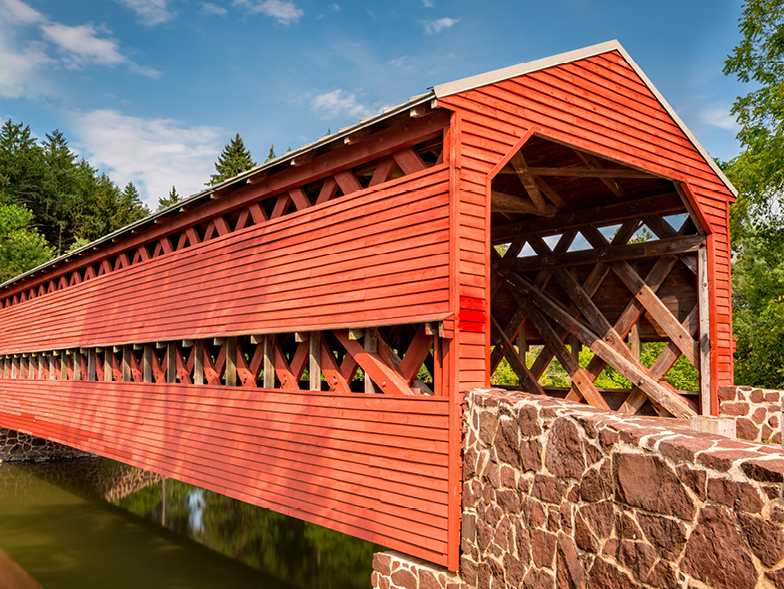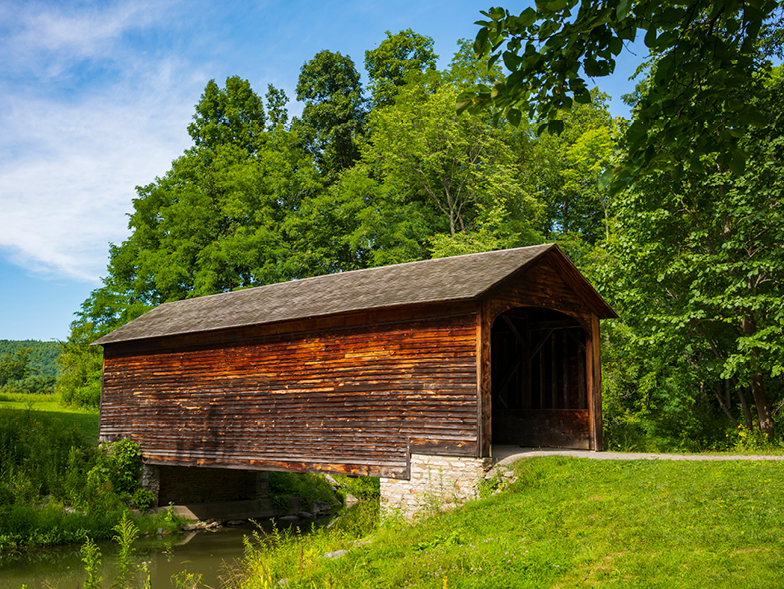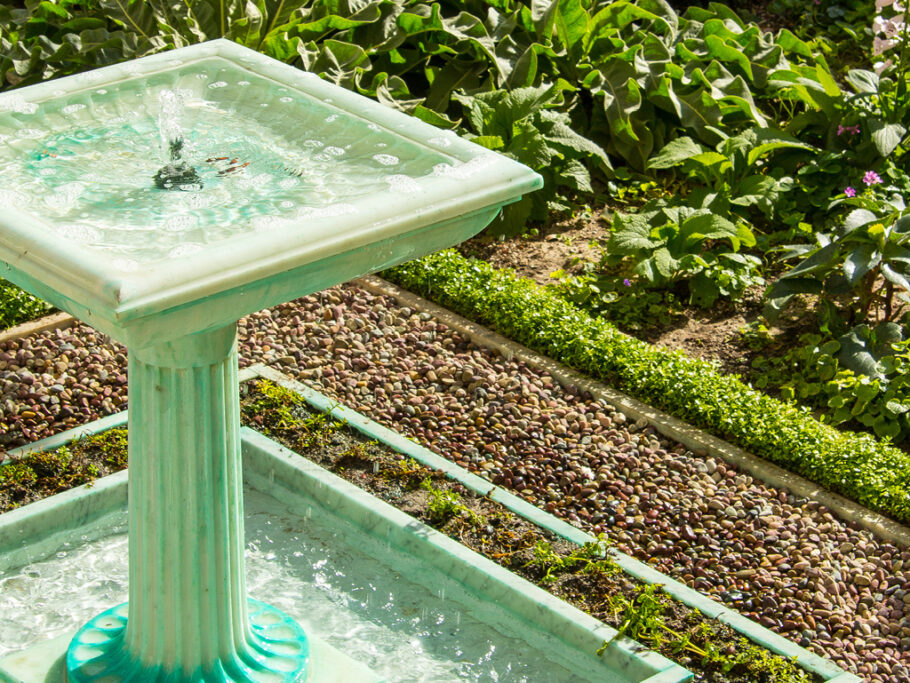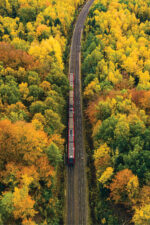Bridging the Past and Present
I live in Bucks County, Pennsylvania. Among other things, this quaint area in the southeastern part of the state is known for its culture, its scenery, and especially its history—there are seemingly endless examples of historic homes, castles, and mansions for both residents and visitors to indulge in.
Among these notable centuries-old structures are covered bridges. In fact, there are still a dozen scattered across the county. Having one in our town, I can vouch from firsthand experience that driving through a historic covered bridge fills you with a sense of awe.
But what exactly makes them so magical to the point that they are romanticized in photos, paintings, books, and movies? Once you deconstruct the history and function of covered bridges in America, you can better understand why the still-standing ones are such a fixture in the fabric of our identity.

Their practical purpose
Back in the early 1800s, America was in its infancy and the country’s enormity was still being explored, which required much travel. As such, it required finding means for horses and buggies to cross over bodies of water—hence the construction of bridges. Wood was plentiful thanks to vast forests of virgin timber, resulting in wooden bridges appearing throughout the country.
The problem? Wood and weather don’t always mix well, so the bridges would usually last a few years, tops. The solution? Adding a cover, which would help protect the precious load-bearing timber and prolong the structure’s life. The United States’ first full-length covered bridge, the ironically named Permanent Bridge, was built in Philadelphia in 1805. It stood for seventy years.
Trusting the truss
Most historic bridges in America feature a truss design. In fact, truss bridges have been used for centuries, and that’s not accidental: they’re a popular choice for their strength. For greater support, truss designs use beams connected in a triangle, which evenly distributes the weight they absorb. Such engineering can be simple, but over the years, many elaborate truss designs have been patented to account for increasingly longer bridges with higher weight loads—allowing covered bridges to flourish in nineteenth-century America.
Covered bridges across the country
At their peak, approximately 14,000 covered bridges dotted the United States. Today, thanks to the influx of concrete and steel, the number of historic wooden covered bridges has dwindled to six hundred or so. Being such a rare historical find, they’re well worth a visit, and you could even help contribute to their preservation if you’re duly inspired.
Here are some of the most noteworthy historic covered bridges to add to your travel to-do list, all of which are listed on the National Register of Historic Places.

The oldest: Hyde Hall Covered Bridge (New York)
Situated in New York’s Finger Lakes is the oldest documented covered bridge in the country, Hyde Hall Covered Bridge. Why the name? When it was built in 1825, it was on the property of a country mansion called Hyde Hall. The state acquired both in 1963 and incorporated them into Glimmerglass State Park, where they can be found to this day.
The longest: Cornish-Windsor (Vermont–New Hampshire)/Medora (Indiana) Covered Bridges
According to the National Society for the Preservation of Covered Bridges, the longest historic covered bridge in America is a matter of debate, or at least definition. The Cornish-Windsor Covered Bridge has a longer truss and is considered to be the longest two-span historic covered bridge in the world, but Medora Covered Bridge actually has a greater overall length. You’ll have to visit both to make your own determination!
Not to be outdone, the longest historic single-span wooden truss bridge in North America is the Bridgeport Covered Bridge in California, which was closed for a decade for much-needed repairs but reopened in 2021.
The most state-connecting: Cornish-Windsor and friends
The Cornish-Windsor Covered Bridge is also one of only three covered bridges in America (along with the Columbia Covered Bridge and the Mount Orne Covered Bridge) that span two states. All three cross the Connecticut River between New Hampshire and Vermont.
The tallest: Felton Covered Bridge (California)
Located near San Jose and built in 1892, this thirty-five-foot-tall structure is available for pedestrian traffic only, which is a good thing—it leaves you more time to gaze up at its sheer expanse.

The quirkiest: Humpback (Virginia), Sach’s (Pennsylvania), and Goodpasture (Oregon)
- Humpback Bridge stands out because it’s true to its name, with its middle section rising four feet above its entrances. Constructed in 1857, it’s the fourth version of the bridge and is the oldest bridge in the state.
- Sach’s Covered Bridge, located in historic Gettysburg, was a key conduit during the Civil War. Today, the hundred-foot-long structure stands out for its intricate latticework, which gives the illusion that it has two stories.
- The popular and picturesque Goodpasture Covered Bridge in Vida, Oregon, is a bit younger than other historic bridges in this guide, having been constructed in 1938. Photographers love to shoot here not only for the scenery but also because of the bridge itself, with its arched louvered windows giving it a chapel feel.
The most festive: Stark Covered Bridge (New Hampshire)
Every year, the town of Stark, New Hampshire, lights up its historic covered bridge and the tiny, historic Stark Union Church next to it to create a one-of-a-kind holiday scene. Bonus fun fact: In the 1890s, this bridge was washed away by high water. Undaunted, men from the town used oxen to bring it back and then set it on stronger stone piers, illuminating the bridge’s importance to the town.
The pop culture icon: Roseman Covered Bridge (Iowa)
This structure, which played a prominent role in the romantic novel and movie The Bridges of Madison County, is one of six covered bridges in the area. It’s also rumored to be haunted, which probably didn’t work as well in the manuscript.
Covered bridges are longstanding testaments to not only America’s romanticism and nostalgia but also its work ethic and ingenuity. As such, these monuments span both bodies of water and centuries, providing instantaneous connection between the country’s past and present for all who pass through them.
For more info, visit coveredbridgesociety.org
































